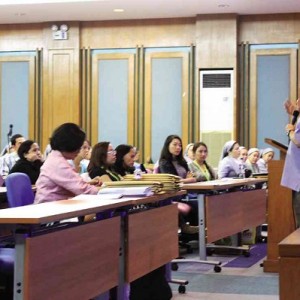How environment experts envision a ‘green hospital’
Glutaraldehyde, a chemical used to clean equipment, has been commonly used in most Philippine hospitals. Yet, it has been found to be a respiratory irritant and linked to occupational asthma and asthma-like symptoms such as throat and nose irritation, sneezing, wheezing, and breathing difficulty.
While this chemical is already banned in the United States, a number of local hospitals have been found to continue using it, and disposing of it improperly through regular drainage.
This was revealed by Health Care Without Harm-Asia director Merci Ferrer during the July 29 launch of the report “From the Backyard to the Frontline” at the St. Paul de Chartres Renewal Center in Alfonso, Cavite. The event also highlighted the five featured hospitals doing good practices.
Best practices
The launch of the report was also part of the pre-anniversary activities of HCWH-Asia, which just turned 10 years old. “From the Backyard to the Frontline” will be published by HCWH-Asia in cooperation with the UNDP-Global Environmental Facility Global Health Care Waste Project. The report discusses Philippine hospital workers’ best environmental practices and features some of the best practices in hospitals from different parts of the country.
Article continues after this advertisementSome of these are:
Article continues after this advertisement• The zero-waste practice at Maria Reyna-Xavier University Hospital in Cagayan de Oro City;
• Safe practices to prevent radiation exposure in General Santos Doctors Hospitals;
• Use of safer alternatives for hospital cleaning at St. Paul Hospital, Tuguegarao City;
• Sustainable energy production through a biodigester at Perpetual Succor Hospital in Cebu City;
• Wastewater treatment at Our Lady of Peace in Las Piñas and Philippine Heart Center; and
• Mercury-free dental service at San Lazaro Hospital.
Sonia Astudillo, HCWH-Asia communications and press campaigner, pointed out to Inquirer Science/Health that, “while hospitals are there to heal, we cannot deny that there are practices that are harming not just the patients but the hospital workers and even people within the same locality.”

Dr. Jorge Emmanuel (left), chief technical advisor for UNDP GEF project, encourages the healthcare industry to be part of the global network of hospitals sharing good practices
Currently, HCWH-Asia is in the midst of a campaign known as the Global Green and Health Hospitals (GGHH). The GGHH Network is a conglomeration of hospitals, health systems and health organizations that represent the interests of over 3,500 hospitals spanning six continents. The network is composed of members committed to implementing 10 interconnected goals aimed to reduce ecological footprints and promote public environmental health.
10 goals
Ferrer enumerated the 10 goals for achieving an environment- and people-friendly hospital:
• Leadership that prioritizes environmental health;
• Chemical substitution to replace harmful chemicals with safer alternatives;
• Waste reduction, treatment and safe disposal of healthcare waste;
• Energy efficiency and renewable energy generation;
• Water reduction and supply of potable water;
• Improved transportation strategies for patients and staff;
• Food purchasing and availability of sustainably grown and healthy food;
• Safe management and disposal of pharmaceuticals;
• Building design and construction that support green and healthy hospitals; and
• Purchasing safer and more sustainable products and materials.
“By looking at or focusing on the 10 goals, we are addressing bad practices from all angles. We deal with the harmful chemicals and waste directly, and we also deal with the management (leadership) side, so we will have policies backing us up,” Ferrer said.
Of particular concern is the use and disposal of water, she observed. “For water reduction and supply of potable water, wastewater must be treated so it can be reused for an organic garden, (the harvests of which) would then be served to patients.” Several hospitals, Astudillo disclosed, are already growing organic gardens within their premises, such as the Philippine Heart Center.
Good examples
During the launch, Dr. Jorge Emmanuel, chief technical adviser for the UNDP-GEF project, encouraged other hospitals present at the launch to follow the good examples of the featured hospitals. He also urged hospitals who are already members of the GGHH Network to continue to be part of the network in the long run. Six of the seven hospitals featured are already members of the network.
Ferrer said: “Everything is interconnected, and we believe that we are now at a point when the health system is going beyond their oath of ‘first do no harm.’ Health systems are now healing, and they are healing not just their patients but the environment too.”
